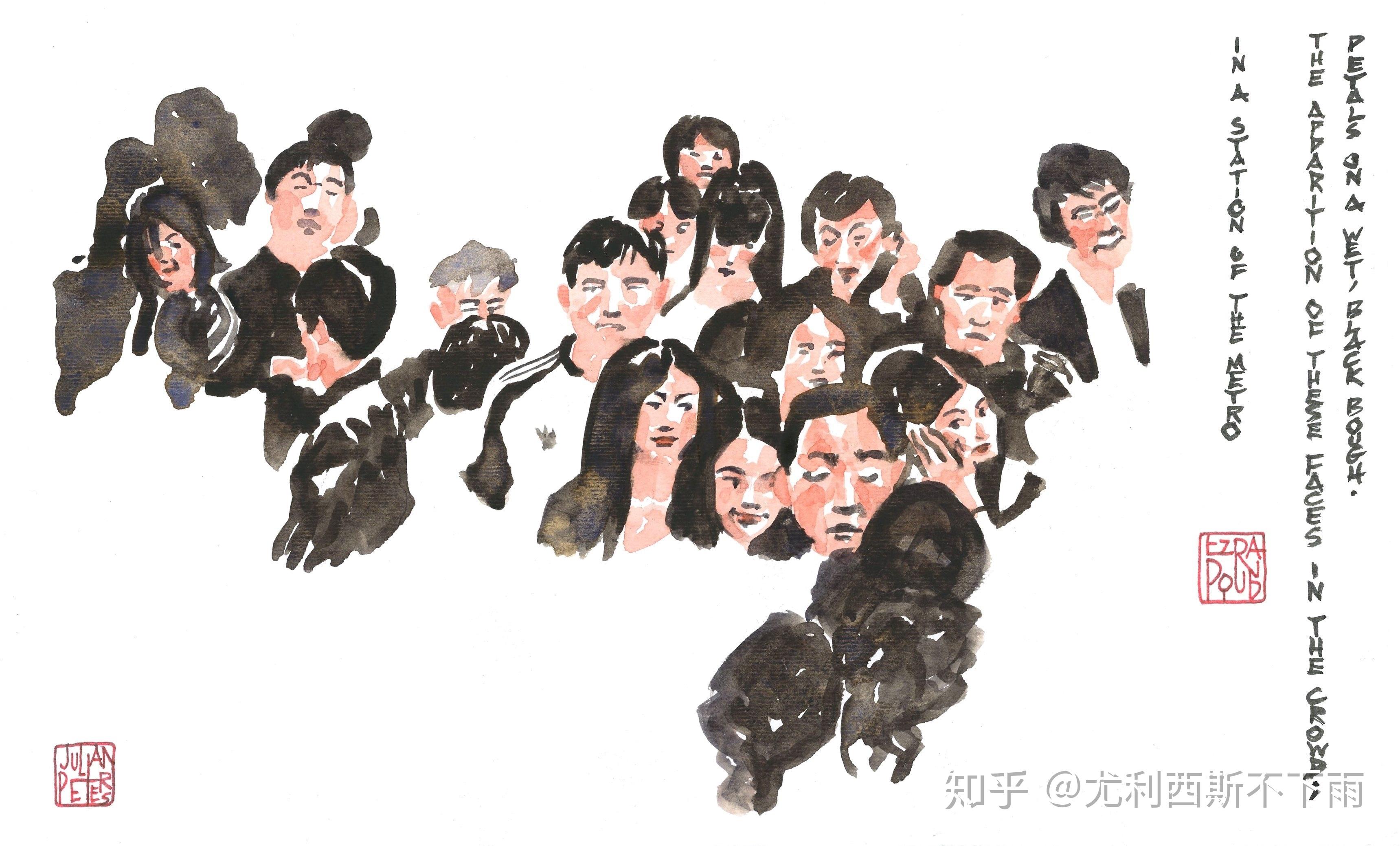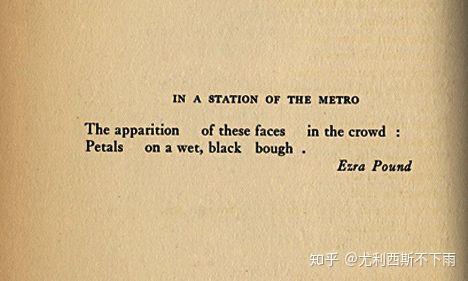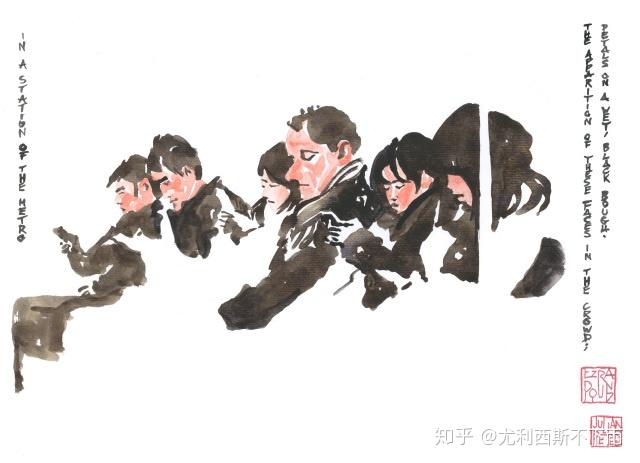英文诗选赏析 | In a Station of the Metro
时间: 2021-09-08 22:39:06 | 作者:尤利西斯不下雨 | 来源: 喜蛋文章网 | 编辑: admin | 阅读: 125次
- 2022-05-30 14:32:11高中语文:诗歌赏析答题技巧和步骤!
- 2021-08-05 21:26:29英文诗歌赏析[Appreciation of English poetry]
- 2021-07-20 18:27:20诗歌赏析65
- 2021-07-13 19:28:27诗歌赏析65
- 2021-06-19 21:29:52诗歌赏析44
- 2021-06-07 21:27:25高考语文:诗歌赏析基础知识
- 2021-04-30 10:52:19诗歌赏析42
- 2021-03-25 12:45:52诗歌赏析34
- 2021-03-25 10:45:52诗歌赏析36
- 2021-03-22 08:42:58诗歌赏析40





In a Station of the Metro
Ezra Pound
埃兹拉·庞德是英美现代诗坛的一位巨匠,他谙熟古今,善于旁搜博采,撷取各国文明之长为己用,尤其尊崇中国文化。1913年,美国著名东方学学者厄内斯特·费诺罗萨(Ernest Fenollosa,1853-1098)的遗孀将费诺罗萨生前16本笔记托付给庞德,其中包括《作为诗歌媒介的中国文字》(The Chinese Written Character as a Medium for Poetry)一文的资料和一些中国古诗详细的英文注释。费诺罗萨在其手稿中对汉字的分析为庞德提供了基本的美学思想。
庞德由此发现汉字是表意文字——一种把意思融入具体形态的象形文字,每一个字都是一个象征符号、一个意象,与客观世界联系紧密。他还翻译了一些李白和王维的诗歌,发现意象之间的系词可以省去,而且这样会产生一种特殊的艺术效果。庞德找到了一种通过并置安排意象的方法,并将其运用到意象派诗歌的创作中,逐渐形成一套意象派诗歌的创作原则,《In a Station of the Metro》便是其创作原则的集中体现。


In a Station of the Metro
The apparition of these faces in the crowd;
人群中幻影般浮现的脸
Petals on a wet, black bough.
潮湿的黑色树枝上的花瓣


写作背景
埃兹拉·庞德(Ezra Pound,1885-1972)是二十世纪美国的著名诗人。他生于爱达华州海利市,在宾西法尼亚州长大。庞德青年时代在哈密尔顿学院和宾州大学读书,主修罗曼司语言,饱览古典文学。在宾州大学学习期间,他结识了两位年轻的诗人——威廉·卡洛斯·威廉姆斯和希尔达·杜利特尔(Hilda Doolittle),从此走上诗歌创作的道路。他熟读英国诗人罗塞蒂(Dante·Gabriel·Rossetti,1828~1882)和史文朋(Algernon·Charles·Swinburne,1837~1909)的诗作,对勃朗宁(Robert Browning,1812~1889)也钦仰备至。此外,美国著名诗人惠特曼的诗歌也对庞德的文学创作产生了全面持久的影响。
1913年春,庞德在巴黎乘坐地铁,当他走出阴湿的地铁时,嘈杂熙攘的人群中一张张美丽面孔忽然映人眼帘,使眼前和心头都为之一爽,不能不使庞德产生了一种“突发情感”而无法自已。这是一种“感受”,需要表达出来,但他苦于找不到适当的文字。诗人在《高狄埃一布热泽斯卡:回忆录》中讲到这一首诗的创作经过时说:
“三年前在巴黎,我在协约车站走出了地铁车厢,突然间,我看到了一个美丽的面孔,然后又看到一个,又看到一个,然后是一个美丽儿童的面孔,然后又是一个美丽的女人,那一天我整天努力寻找能表达我的感受的文字,我找不出……像那种突发情感那么可爱的文字。那个晚上……我还在继续努力寻找的时候,忽然我找到了表达方式。……不是用语言,而是用许多颜色小斑点。这种“一个意象的诗”,是一个叠加形式……我发现这对我为了摆脱那次在地铁的情感所造成的困境很有用。我写了一首30行的诗,然后销毁了,……6个月后,……一年后我写了日本和歌式的诗句:In a Station of the Metro。”
In a Station of The Metro


意象
《在地铁站里》一共只有两句话,十四个单词,创造了四个意象:面孔(faces) 、人群(crowd) 、花瓣(petals) 和树枝(bough) 。全诗虽然一个动词也没有,但每一个名词就是一幅画面,几个画面依次出现,产生一种奇妙的比兴效果,使读者能轻易地把“面孔”(faces) 与“花瓣”(petals) , “树枝”(bough) 与“人群”(crowd) ,甚至与标题中的“地铁站”(station of the metro) 联系在一起。作者采用阴湿的树枝比喻幽暗的地铁以及其中的人群,通过鲜艳的花瓣形容人的美丽脸庞,了了数语便勾勒出气氛融洽、意象鲜明的画面。虽然没有明显的动态景物,但静态的画面经过读者的联想便能铭刻于心。
这种艺术效果正是庞德所刻意追求的。这一点,从庞德创作这首诗的过程中也可以看出。庞德在创作这首诗时,直接采用意象表达主题,删去所有与意象无关的词语,用最为简洁、精炼的语言去捕捉事物的形象,甚至不用动词。这使得仅有的十四个单词的每个词都获得了丰富的含义。如“黑”(black) 既可指火车的黑、铁轨的黑、柱子的黑,也可以指地铁站内光线的黯淡和站台上拥挤的人群的模糊状。而这些意象的表达,既是客观的陈述也是想象的陈述,面孔(faces) 、人群(crowd) 、花瓣(petals) 、树枝(bough) 等是诗人真实的观察和联想的观察,准确地记录了一个外部的、客观的事物变形为或投人到一个内部的主观的事物时的瞬间,符合庞德给意象下的定义:“意象是理智和情感瞬间的复合物”。
艺术手法
其次,在这首诗里,情与景被巧妙地结合起来,通过映衬对比的艺术手法,诗人创造出完美的诗歌境界。庞德认为意象包括具体事物和思想感情两部分,即景与情,而且二者统一于意象中,是密不可分的。在《在地铁站里》这首诗中,一共描绘了四个画面,且两两相对(face对petals, crowd对bough) ,使读者自身能从两两相映的四幅画面中体会内含的意义。因此,这首诗仅仅描绘了作者在一瞬间产生的四个意象,而这四个意象又蕴含着诗人无法言语的感情。
它的主题是朦胧的,可以有许多种解释。其主导意象“花瓣”(petals) 比喻那些美丽的“面孔”(faces) 。“树枝”(bough) 比喻“地铁站”(the station of the metro) 或其中的“人群”(crowd) 。作者在这里或只想单纯描写一个场景,捕捉生活中的一个镜头;或是有感而发,由花瓣般美丽的面孔而念及亲人……也正是这首诗的朦胧的主题,它给读者留下了广阔的思索空间,因而诗歌的容量也就远远超出了十四个单词所表达的内容,使这首诗大放异彩。
在艺术手法上,庞德使用了对比映衬。除上文刚提到的意象之间的两两对比外,在色彩上,还多次用到绘画中的技巧。庞德回忆这首诗时写到:“......突然,我找到的不是一个词,而是一个对等物……不是用语言而是用小小的色点表现的……我在巴黎的经验应该用颜料表达”(庞德《高狄埃-布热泽斯卡:回忆录》)。诗歌《在地铁站里》是一幅以黑色为基调的色彩丰富的图画,诗中的词语显然起到了颜料的作用:“花瓣”(petals) 本身就代表色彩;“湿”(wet) 一词含有一种清新、鲜亮的感觉;“出现”(apparition意为幻象的出现) 赋予脸和花瓣一种苍白、虚弱的朦胧色;“花瓣”(pet as)和“面孔”(faces) 并置又使脸具有了柔和、红润的色调。作者利用这种色彩上的反差,把几张漂亮的面孔从光线黯淡的地铁环境中突显出来。这种反差也正好说明和喧闹的工业都市相比,美好的事物是何等柔弱。
韵律
诗歌《在地铁站里》,音韵和谐,旋律优美,是诗歌与音乐相结合的产物。诗中的两个句子完全按照现代自由诗体(free verse) 的格律,由富于音乐节奏的短句组成。除了在black bough中押头韵(alliteration) 和两句句末元音叠韵之外, 基本上没有明显的韵律,但音乐短句的节奏却很明显。
第一句有两个短句:The apparition of these faces和in the crowd.作者用的是一个多音节词(apparition)和含有长元音或双元音的词,使第一句读起来平稳而舒缓;第二句本身就是一个音乐短句,句中的词都是单音节词,而且多以短元音为主,读起来急促而流畅,是作者在捕捉事物和情感相结合的一瞬间时产生的艺术火花。在这两句中作者不采用音步表现节奏,而以短语、短句为单位形成语调急徐高低的自然节奏,具有一种音乐的美感。
庞德认为诗不仅是一种心境,而且是一种技巧。为了寻找可能的技巧,庞德把触角伸进了诗歌以外的艺术领域。他很早就试图把诗歌和音乐结合起来,认为诗的音乐美在于句中字与字间的错落起伏,而不是行与行间的重复押韵。诗歌的节奏应该多样化,每一种感情都有与之相适应的节奏,一个诗人应该像音乐家那样创造读者喜爱的节奏。而节奏,则应该是用音乐性短句来反复演奏的,而不是用“节拍器”反复演奏来进行创作的。因此,他认为当时读者所熟悉的五音步是一个巨大的障碍,并宣称:“冲破五音步,这是第一次飞跃”。庞德以口语的节奏代替传统格律,把英美诗歌从衰落、讲究修饰和机械呆板的节奏中解放出来,把诗歌从古雅的、文绉绉的中世纪“音乐”转变成自然灵活、富于弹性的现代“音乐”。


Themes
Perception, Imagination, and Reality
“In a Station of the Metro” is concerned above all with imagery: the speaker sees a bunch of people in a subway station and this prompts the speaker to envision petals on a tree branch. This shift is remarkably sudden: in just two lines—a fleeting instant—the speaker sees both petals and a crowd of faces, and manages to vividly convey both images to the reader.
The poem's brief form allows it to combine both forms of perception (one happening before the speaker’s eyes, and one happening in their mind), creating a new, blended reality from the speaker's point of view. Overall, then, the poem might be thought of as an attempt to capture the connection between sight and imagination—revealing how these two processes together shape people's perception of the world around them.
Pound strips the poem of all superfluous language. Including the title, the poem uses just 20 words—meaning there is nothing to focus on besides the pair of images and how they relate to each other. The poem’s structure thus allows for a clear association between the what the speaker sees (“faces in the crowd”) and what the speaker imagines in response (“petals on a wet, black bough”).
The poem also notably doesn't use any verbs. Instead, it is isolated to the rawest, most basic descriptions of images, which contribute to the spontaneity of the speaker’s visual association. In other words, the poem seems to catch the speaker in the act of visually processing a connection between “faces” and “petals” before the speaker even has time to form a complete thought! This verbless quickening creates a mingling between the two images as though the speaker sees “faces” and “petals” at the same time, or perhaps in oscillation.
A close reading of the poem's language further reveals how the “apparition of these faces in the crowd” could indeed look like “petals on a wet, black, bough.” The word “apparition” could simply suggest the act of appearing, or it could denote something “ghostly.” The “faces” are certainly appearing before the speaker, but there is also a ghostly—or at least blurry—quality to a big crowd of people standing in a dimly-lit metro station. Readers can imagine, then, how the blurred, partially-obscured “faces” might have led the speaker to see something else.
“Faces” in a “crowd” may be different from “petals” on a “bough,” but the poem suggests that they are each visual fixtures of similar spaces. In a metro station, crowds line up on either side of a long train track just as petals stem from either side of a branch. The words “crowd” and “bough” even share assonance, which invites such a visual comparison between their shapes.
Furthermore, the adjectives modifying “bough” (“wet” and “black”) could also describe the metro station itself: “black” may be appropriate given the station’s dark, underground setting, while “wet” could describe the shimmering metal of the train and its tracks, or even leftover rain on pedestrians’ jackets.
Although readers are left to wonder why the speaker draws a visual link between “faces” and “petals,” the poem is not concerned with explaining anything about the speaker or their circumstances. Rather, it is a poem that portrays the instantaneous connection between eye and brain as an association sparks from an image, perhaps celebrating the sudden artistry of this imaginative process.
也 许 你 还 喜 欢
英文诗选赏析 | Love’s Philosophy
英文诗选赏析 | Break,Break,Break
英文诗选赏析 | O Captain!My Captain!


[英文诗选赏析 | In a Station of the Metro] 相关文章推荐:
- 最新散文
- 热门散文
- 热门文章标签
全站搜索